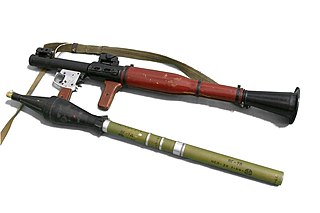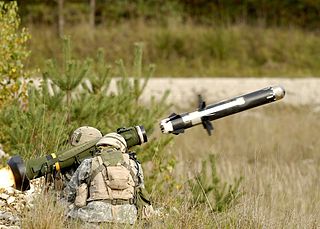
A rocket-propelled grenade (RPG) is a shoulder-fired missile weapon that launches rockets equipped with an explosive warhead. Most RPGs can be carried by an individual soldier, and are frequently used as anti-tank weapons. These warheads are affixed to a rocket motor which propels the RPG towards the target and they are stabilized in flight with fins. Some types of RPG are reloadable with new rocket-propelled grenades, while others are single-use. RPGs are generally loaded from the front.

An anti-tank guided missile (ATGM), anti-tank missile, anti-tank guided weapon (ATGW) or anti-armor guided weapon is a guided missile primarily designed to hit and destroy heavily armored military vehicles. ATGMs range in size from shoulder-launched weapons, which can be transported by a single soldier, to larger tripod-mounted weapons, which require a squad or team to transport and fire, to vehicle and aircraft mounted missile systems.

The Stryker is a family of eight-wheeled armored fighting vehicles derived from the Canadian LAV III. Stryker vehicles are produced by General Dynamics Land Systems-Canada (GDLS-C) for the United States Army in a plant in London, Ontario. It has four-wheel drive (8×4) and can be switched to all-wheel drive (8×8).

Arena is an active protection system (APS) developed at Russia's Kolomna-based Engineering Design Bureau for the purpose of protecting armoured fighting vehicles from destruction by light anti-tank weapons, anti-tank guided missiles (ATGM), and flyover top attack missiles. It uses a Doppler radar to detect incoming warheads. Upon detection, a defensive rocket is fired that detonates near the inbound threat, destroying it before it hits the vehicle.

The Avenger Air Defense System, designated AN/TWQ-1 under the Joint Electronics Type Designation System, is an American self-propelled surface-to-air missile system which provides mobile, short-range air defense protection for ground units against cruise missiles, unmanned aerial vehicles, low-flying fixed-wing aircraft, and helicopters.
An active protection system (APS) is a system designed to actively prevent certain anti-tank weapons from destroying a vehicle.

Trophy is a military armored vehicle active protection system (APS) designed by Rafael Advanced Defense Systems.

An infrared countermeasure (IRCM) is a device designed to protect aircraft from infrared homing missiles by confusing the missiles' infrared guidance system so that they miss their target. Heat-seeking missiles were responsible for about 80% of air losses in Operation Desert Storm. The most common method of infrared countermeasure is deploying flares, as the heat produced by the flares creates hundreds of targets for the missile.

Iron Fist is a hard-kill active protection system (APS) designed by Israel Military Industries (IMI), with a modular design allowing adaptation to a range of platforms ranging from light utility vehicles to heavy armoured fighting vehicles. The concept was revealed by IMI in 2006 and was expected to enter Israel Defense Forces tests by mid-2007. The system has been successfully tested against a wide variety of threats including rocket-propelled grenades, anti-tank guided missiles and tank-fired high-explosive anti-tank (HEAT) ammunition and kinetic energy penetrators.

Short range air defense (SHORAD) is a group of anti-aircraft weapons and tactics that have to do with defense against low-altitude air threats, primarily helicopters and low-flying aircraft such as the A-10 or Sukhoi Su-25. SHORAD and its complements, HIMAD and THAAD divide air defense of the battlespace into domes of responsibility based on altitude and defensive weapon ranges.

Slat armor, also known as bar armor, cage armor, and standoff armor, is a type of vehicle armor designed to protect against high-explosive anti-tank (HEAT) attacks, as used by anti-tank guided missiles (ATGMs) and rocket-propelled grenades (RPGs).

Boomerang is a gunfire locator developed by DARPA and BBN Technologies primarily for use against snipers. Boomerang is mounted on mobile vehicles such as the Humvee, Stryker, and MRAP combat vehicles. There were plans to integrate it into the Land Warrior system.
AMAP-ADS is a hard-kill active protection system (APS), developed by the German company ADS Gesellschaft für aktive Schutzsysteme, a subsidiary of Rheinmetall and IBD Deisenroth Engineering, as part of their Advanced Modular Armor Protection concept. The system is also known under the name AAC in Sweden and as Shark in France. Due to its modular design it can be adapted to a broad range of vehicles. In particular, it is capable of protecting light vehicles against large caliber weapons which the vehicles' light armor wouldn't stop.

The RPG-30 "Kryuk" is a Russian hand-held disposable anti-tank grenade launcher.

The Ground Combat Vehicle (GCV) was a program initiated by the United States Army in 2009, with the goal of developing a next-generation armored fighting vehicle. The first variant of the GCV to be developed would be an infantry fighting vehicle to replace the M2 Bradley.
Quick Kill is an active protection system (APS) designed to destroy incoming anti-tank missiles, rockets, and grenades. The Quick Kill system is designed and produced by Raytheon for the U.S. Army. The Quick Kill system was part of the United States Army's Future Combat Systems.

Artis is a research and development company located in Herndon, Virginia. Founded in 1999, the company provides services and creates products for defense and commercial markets using extremely high-speed sensing and parallel processing. The name of the company stems from an acronym, short for "advanced real-time information systems."
In air and missile defense (AMD), the Integrated Air-and-Missile Defense system (IAMD) is an SMDC research program to augment the aging surface-to-air missile defense systems and to provide the United States Army with a low-cost, but effective complement to kinetic energy solutions to take out air threats. Brigade level higher energy lasers are used in truck mounted systems called HELMTT. At lower levels, the Army needs to develop interceptors that don't cost more than small, unmanned aircraft systems. In early research they have successfully used 5-kilowatt lasers on a Stryker combat vehicle. The Mobile Expeditionary High-Energy Laser (MEHEL) was used at MFIX at Fort Sill, Oklahoma, in the first half of April, 2017.

KAPS is an active protection system developed by the Agency for Defense Development (ADD) and Hanwha Thales for K2 Black Panther in 2011. It was decided to introduce a hard-kill active protection system to strengthen the survival of South Korean main battle tanks (MBT), and the development was completed under the leadership of ADD from 2006 to December 2011.















